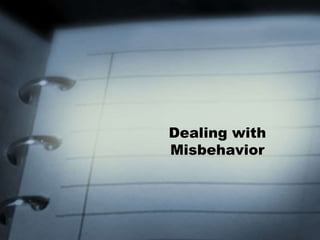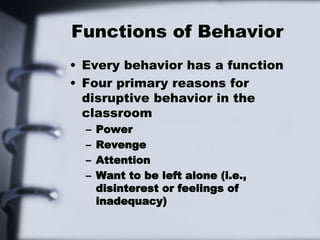16 Classroom management.ppt
- 2. Introduction – It’s effective discipline – It’s being prepared for class – It’s motivating your students – It’s providing a safe, comfortable learning environment – It’s building your students’ self esteem – It’s being creative and imaginative in daily lessons
- 3. Goals for Classroom Management • Time for learning –Allocated time –Engaged time or time on task –Academic learning time • Access to learning • Participation structures • Self-management
- 4. Importance of Classroom Management • Satisfaction and enjoyment in teaching are dependent upon leading students to cooperate • Classroom management issues are of highest concern for beginning teachers • Classroom management and effective instruction are key in ensuring student success and learning
- 5. Classroom Procedures • Administrative routines • Student movement • Housekeeping • Lesson routines • Teacher-student interactions • Student-student interactions
- 6. Rules for Making Rules • Do’s and don’ts • Often written down and posted • Set the atmosphere • Consistent with school rules • Consistent with principles of learning • Make a few, good rules
- 7. Categories of Penalties Contact parents Express disappointment Lose privileges Exclude from group Write a reflection Detention Visit the principal’s office
- 8. Maintaining a Good Environment for Learning • Busy students are better behaved • Supervise students closely • Include cues for desired behaviors • Clear steps for activities • Provide necessary materials • Engage students in authentic tasks • Employ curiosity, interest
- 9. YOU SET THE TONE • Set the tone for everything…behavior, procedures, grades, work ethic, attitude…everything!! • Teach students to manage their own behavior • Students LEARN to be on-task and engaged in the learning activities you have planned for them…REMEMBER THIS…
- 10. • Be fair, firm and consistent…remember that students are, by nature, the morality police. • They can spot inconsistencies a mile away and take joy in calling you out on it!! • Students may not enjoy consequences of inappropriate behavior but they will respect your decisions if they know that you are fair and apply discipline/consequences fairly
- 11. POSITIVE IS A PLUS • Build a positive, PROFESSIONAL rapport with students • Establish a positive classroom environment… • Model the positive behaviors and attitude you desire in your students
- 12. PLAN, PLAN, PLAN • Planning engaging, purposeful lessons is one of the best recipes for a smooth, orderly classroom • Over plan your lessons to minimize waste of time • Plan lessons that address multiple learning styles and allow all students to experience success
- 13. BE PREPARED!! • Be organized • Be on time • Be prepared for changes to your even the “best plans” • Have a plan B • Have a plan C • Anticipate possible hiccups in your lessons and activities
- 15. DEVELOP EFFECTIVE BEHAVIOR CUES • Focus attention on entire class • Don’t talk over student chatter • Silence can be effective • Use softer voice so students really have to listen to what you’re saying • Raise your hand
- 16. Transition vs. Allocated Time • Allocated time: the time periods you intend for your students to be engaged in learning activities • Transition time: time periods that exist between times allocated for learning activities for e.g; Getting students assembled and attentive
- 17. KEEP IT SIMPLE • Make classroom rules simple • Keep classroom procedures simple • Give clear and simple instructions during classroom activities • Remember that even adults can only process 3-4 instructions at a time effectively!!
- 18. CLASSROOM ARRANGEMENT • Make sure all students can see and hear clearly (and you can see them clearly) • Arrangement is determined by learning activity (lecture, class discussion, small group work, etc.) • Allow room and easy access for proximity control • Think through class procedures and learning activities and arrange the room in the best possible way
- 19. WITH-IT-NESS • Withitness refers to a teacher’s awareness of what is going on in the classroom
- 20. A teacher has “with-it-ness” if: • When discipline problems occur, the teacher consistently takes action to suppress the misbehavior of exactly those students who instigated the problem • When two discipline problems arise concurrently, the teacher deals with the most serious first
- 21. With-it-Ness (continued) • When handling misbehavior – make sure all students learn what is unacceptable about that behavior • Getting angry or stressed does not reduce future misbehavior • Deal with misbehavior without disrupting the learning activity
- 22. PROXIMITY AND BODY LANGUAGE • Eye contact, facial expressions, gestures, physical proximity to students, and the way you carry yourself will communicate that you are in calm control of the class and mean to be taken seriously. • Be free to roam • Avoid turning back to class
- 23. DEVELOP EFFECTIVE BEHAVIOR CUES • Focus attention on entire class • Don’t talk over student chatter • Silence can be effective • Use softer voice so students really have to listen to what you’re saying • Raise your hand
- 24. PROACTIVE VS. REACTIVE • By using proactive teaching and classroom management strategies, more time is spent on teaching and learning and less on reacting and putting out fires. • Being proactive means paying it forward before class starts but receives huge dividends in the end!!
- 25. USING HUMOR • Use humor when appropriate • Be able to laugh at yourself • NEVER use sarcasm • Sarcasm puts students on the defensive and damages your relationship
- 26. EVERY PERFORMER NEEDS A STAGE • Confrontation gives students a “stage” to perform • Avoid power struggles…no one wins • Give students a dignified way to get out of a bad situation • Address behavior issues in private whenever possible
- 27. IT IS NOT PERSONAL • Kids misbehave…that is their job! • Kids test boundaries and limits…it is a natural part of growing up! • Kids don’t always do what we want them to…no matter how much they like us! • DON’T TAKE IT PERSONNALY!!
- 29. Functions of Behavior • Every behavior has a function • Four primary reasons for disruptive behavior in the classroom – Power – Revenge – Attention – Want to be left alone (i.e., disinterest or feelings of inadequacy)
- 30. Functions of Behavior • Many misbehaviors exhibited by students are responses to a behavior exhibited by the teacher • Understanding the function of a behavior will help in knowing how to deal with that behavior
- 31. Dealing with off-task behaviors • Either respond decisively or ignore it all together • Control the time and place for dealing with off-task behavior • Provide students with dignified ways to terminate off-task behaviors • Make specific references to behaviors, do not make it a personal attack
- 32. Dealing with off-task behaviors • Remember that continuing with classroom instruction is always the main priority!! • Utilize alternative lesson plans • Utilize the help of colleagues • Communicate and enlist the help of parents/guardians
- 33. Power Seeking Behavior • Power-seeking students attempt to provoke teachers into a struggle of wills • In most cases, the teacher should direct attention to other members of the class
- 34. Attention Seeking Behavior • Attention-seeking students prefer being punished, scolded, or criticized to being ignored • Give attention to this student when he or she is on-task and cooperating • “Catch them being good!” – and let them know you caught them


































